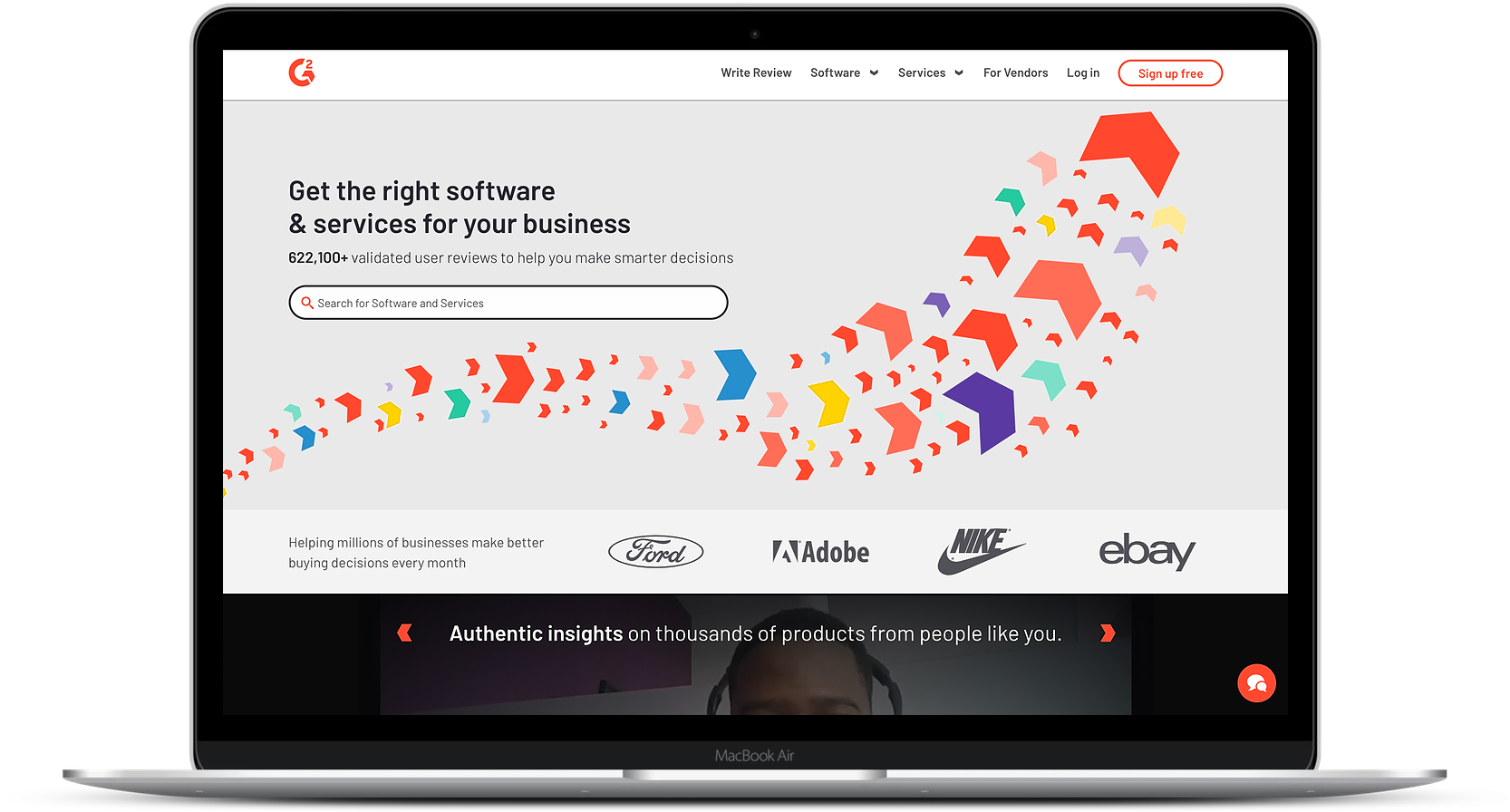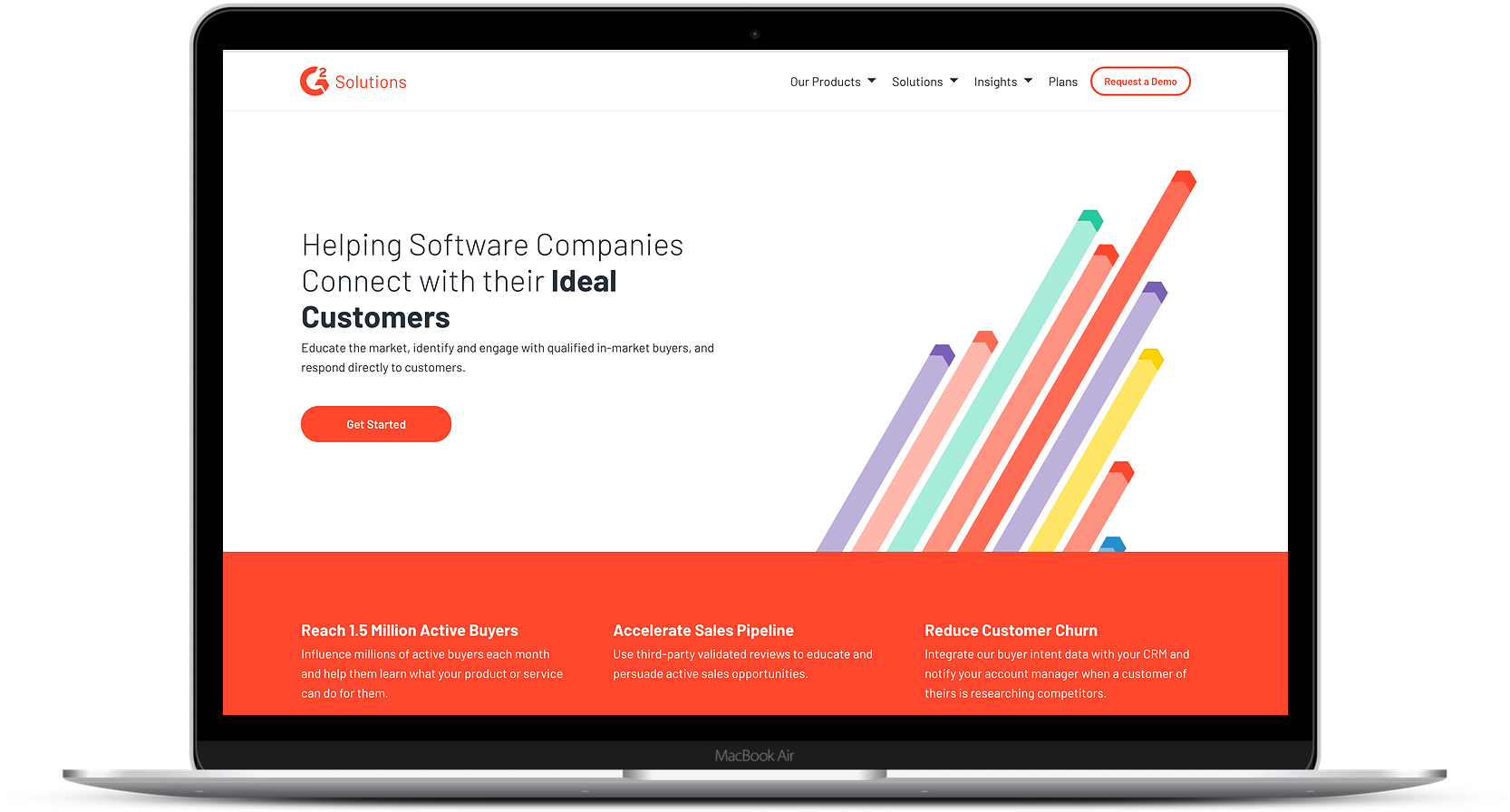When I first walked into G2 Crowd’s Chicago office in for a meeting with their CMO, I hoped to introduce myself and ideally trade a few ideas and an introduction or two. I had no intention of joining their team, but that half hour meeting turned into an hour an a half, and I walked with a job offer I couldn’t refuse: design your own job description. My head was spinning with ideas - and while I didn’t design a bespoke role (how could I without knowing the team?!), I came back a week later instead with a document brainstorming recommendations and opportunities to take the G2 Crowd brand to the next level, in the form of refreshed corporate narratives and impactful integrated marketing initiatives.
This is that document, and this is the story behind the rebrand of one of the tech industry’s fastest-growing companies.
THE COMPANY.
G2 Crowd was conceived in a basement by five SaaS technology entrepreneurs that loved working together and loved building companies that helped entrepreneurs thrive. While building former SaaS technology businesses, the founders were frustrated by industry analysts, who they felt were biased and out of touch, restricting their access to the market, and their market’s access to them.
Their mission was to bring transparency to B2B to the business marketplace through crowd-sourced reviews from real customers, changing the way businesses select (and sell) software and services. They built a platform that was that — and so much more. On the surface, G2 Crowd is a review platform, but their true power lies in the community of users and the data behind each review and interaction on the platform, powering real-time insights that provide an unmatched view into the state of the B2B software and services landscape. They know the vendors, the users, how the tools work together, and who’s looking for answers in a way that few other companies can claim.
THE OPPORTUNITY.
With new executive leadership at the helm, an injection of capital, and an acquisition on the horizon, G2 Crowd was at a tipping point and struggling with an identity crisis. Their brand narratives were convoluted and complicated. Their voice was inconsistent, and their visual identity was drab, outdated, and confused.
G2 has a lot to love: an exceptional team, an award-winning culture, a market-leading product, and a vocal, engaged community of users and customers that loved them. But, the brand did not reflect their character, potential for impact, or the genuine passion surrounding the company or the platform.
G2 Crowd needed to move away from the anti-analyst identity they were founded upon and develop a clear north star that was both specific enough to align the team and the business, and bold enough to unlock new opportunities. They had come a long way in 6 years, and our goal was to position the platform not only as a legitimate force to be reckoned with, but an engine for a movement impossible to ignore.
THE APPROACH.
I found lots of inspiration planning our approach to the project. I loved the systematic way Asana unearthed the core of their brand first, identifying brand attributes to articulate a clear personality. I loved how Airbnb’s positioning and ‘live like a local’ tagline defined a bold, yet specific vision that challenged their audience to think differently about how to engage with their world. We especially loved the way companies like Patagonia, Hubspot, Drift, Catalant, Zuora and countless others take a stand against the status quo, not their competition, by selling a movement and an entirely new mindset -- not a product or a solution to a pain point.
We decided to merge these approaches and set out to identify and own G2 Crowd’s intentions and impact in a clear brand identity, articulated within a cohesive brand story and a movement in the market. We would then follow asana’s lead, leveraging our core identity and brand story as a guide to define a visual identity that brought the story to life and captured the energy, passion, and limitless potential of G2 Crowd.
Check out the slide deck on our approach, inspiration and frameworks, which I presented to the marketing team at the start of this project:
THE RESEARCH.
I dove in, leveraging qualitative research approaches to understand internal and external perceptions and impacts of G2 Crowd’s product, culture, positioning and competitive landscape, including:
Interviewing internal leadership, investors, customers and employees
Reviewing sales enablement trainings, marketing materials, and press coverage
Analyzing customer and employee sentiment through Glassdoor and G2 reviews
Analyzing market trends and competitors through research, win/loss reasons, and internal knowledge synthesis
THE STORIES.
Powerful themes and visceral stories began to emerge from this research, and I got to work synthesizing core narratives and a strategic messaging framework.
G2’s unique business model as a marketplace for vendors and a free resource for buyers and users brought challenges in tailoring our message, a challenge every marketplace model wrangles. We recognized that our brand messages needed to resonate with everyone, especially since there was so much overlap between out buyers and sellers, but one of G2’s founding values, ‘buyers come first,’ helped guide our ‘front door message’ decision.
I can’t share most of our initial drafts, but a few initial themes are below, and I’d be happy to talk through how we wove these ideas together and applied them across the organization.
Articulating our Impact: How G2 is Changing the Game
Articulating these initial narratives was easy. Aligning on our story was harder, largely because of a fundamental truth perhaps best articulated by Ben Horowitz: “the story is the strategy…companies that don't have a clearly articulated story don't have a clear and well thought-out strategy.” He continues, “You can have a great product, but a compelling story puts the company into motion. If you don’t have a great story it’s hard to get people motivated to join you, to work on the product, and to get people to invest in the product.”
In other words, a compelling brand story communicates fundamental truths about a company, and is felt in every interaction. It cannot be plagiarized, reverse engineered, or executed in isolation. This is not simply a marketing initiative to add pizazz and get more clicks -- it is a strategic leadership initiative that must be authentic, cohesive, and consistent across the company and the culture. For B2B brands like G2, stories must align with strategics business goals, resonate viscerally with real people, and be simple enough to be codified and shared by the entire organization. A great company story, therefore, requires involvement and collaboration from the highest levels of leadership to get in the weeds, make hard decisions, and align resources to make sure that story is credible.
We brought in the folks at Moving Brands for guidance in refining and aligning on our narratives, and to bring our new brand identity to life through a cohesive visual identity and a dynamic design language. They reviewed our research and initial storylines, led a full-day creative workshop with key stakeholders across the organization, and we worked closely together in the 12 weeks following to launch a brand new G2.
ONWARD AND UPWARD: THE NEW G2.
In a decision to own a natural colloquialism and create a flexible architecture that could expand with the company, G2 Crowd became simply G2, and the new brand identity launched with the Marketing team’s largest campaign of the year, G2’s Best Software Awards.
We landed on a logo that was an evolution of the old one rather than something completely new, modernizing an outdated design while incorporating a symbolic element of upward trajectory through constant iteration.
The design language centers around the arrow in the logo, which comes alive in motion and within a color palette that is warm, vibrant, strategic, and approachable — and as bold and disruptive as the mindset with which our founders hoped to upend the analyst market. We settled for a deep coral as our primary color, which stood out against neutral backgrounds of white and grey and found vibrancy against accents of blue, yellow, teal and purple.






